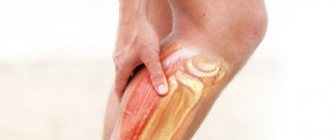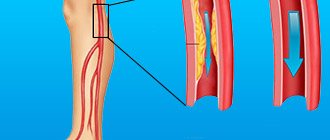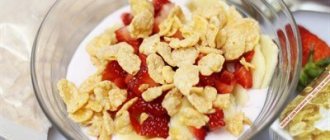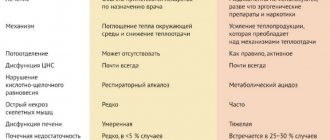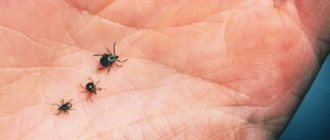Atherosclerosis, damage to large vessels and arteries, ischemia, heart attack, angina, stroke - this is only an incomplete list of the consequences that high cholesterol leads to, not to mention poor health. In addition to drug treatment and folk remedies, nutrition plays an important role in therapy for this pathology.
You need to know how to distribute essential nutrients (BJU) among different meals, how to create a menu, which foods to exclude from it, and which, on the contrary, to focus on. As practice shows, organizing a proper diet for hypercholesterolemia is the key to recovery and reducing the risk of developing the above complications.
There is a special diet for high cholesterol, which allows you to organize nutrition so that it becomes part of the treatment program.
The essence
Brief description of the diet. Type: therapeutic, hypolipidemic. Duration: until cholesterol levels normalize or for life if hypercholesterolemia is chronic or there is a predisposition to it. Results: keeping LDL concentration in the blood within normal limits, minimizing complications. Difficulty: medium.
For high cholesterol, a diet is prescribed, which is characterized by the following features:
- constant monitoring of daily caloric intake;
- compliance with the principles of proper nutrition;
- optimal balance of all nutrients necessary for the body (BJU);
- using the characteristics of a balanced diet: taking into account climate, concomitant diseases (hypertension, Gilbert's syndrome, obesity, diabetes), age, cholesterol level, gender differences, degree of complications.
The main feature of the diet is its therapeutic effect. It is intended primarily to normalize well-being and reduce the risk of complications. Therefore, first you need to consult with a specialist (therapist, cardiologist, phlebologist) to clarify the diagnosis, and then, with the test results and doctors’ conclusions, contact a nutritionist who will help you create the right menu. Subsequently, based on it, you can develop your own version of the diet.
Peculiarities
The diet takes into account the gender and age characteristics of the patient.
Gender
High cholesterol in women is associated primarily with their cravings for sweets, constant weight fluctuations (either dieting or overeating) and hormonal changes. Therefore, a lipid-lowering diet for them is based on limiting complex carbohydrates and prohibiting any fasting. In addition, it is compiled taking into account pregnancy, the postpartum period and the onset of menopause after 45-50 years. The most difficult thing is to give up cakes, ice cream, sweets, pastries, and fast food.
The advantage of this therapeutic nutrition system for women is the availability of an option for overweight. It allows you to reduce your daily caloric intake to the permitted level and keep your body weight under control without strict restrictions.
High cholesterol in men is usually diagnosed due to abdominal obesity, physical inactivity, and abuse of fatty and salty foods. Therefore, a lipid-lowering diet categorically prohibits them from drinking alcoholic drinks with high-calorie snacks, and also recommends that they simultaneously exercise, but in moderation, according to a separate program.
Age
If high cholesterol is diagnosed in a child, a lipid-lowering diet is prescribed to him with great caution and only with strict adherence to all the specialist’s recommendations. Despite the fact that for adults it involves a significant restriction of fats, in childhood this is unacceptable, as it will negatively affect the development of the nervous system. Therefore, the same dairy products should remain in the diet completely. But fast food and sweets should be limited (you shouldn’t ban them at all), finding healthy alternatives for them.
The same applies to those who were diagnosed with high cholesterol after 50 years of age. Restrictions should be approached with extreme caution, otherwise you can harm your health. The risk of diabetes also increases at this age. Therefore, you need to constantly monitor your blood glucose levels and take into account the glycemic index of foods when choosing a menu.
Reminders
For those who are prescribed a diet against high cholesterol, the attending physician usually issues accompanying instructions. They reflect the basic principles of nutrition for this pathology. They must be followed strictly if there is a desire to recover.
Important note. The numbers in the instructions may vary, as the doctor and nutritionist adjust them depending on the individual course of the disease.
Product reminder:
- Fruits are eaten fresh every day, preferably seasonal ones. Make homemade juices from them.
- Vegetables - fresh, as well as stewed, baked, steamed and boiled. According to the season. Make homemade juices from them (without adding spices and salt).
- Legumes - 2 times a week.
- Meat - not fatty (beef, veal, turkey, chicken, rabbit) and not fried.
- Dairy products - low-fat or low-fat.
- Vegetable oil is for dressing salads; you cannot fry with it. Cold pressed. The daily norm is 2 tbsp. l.
- Salt - 5 g per day.
- Sugar - 50 g.
Nutrient Reminder:
- Complex carbohydrates - 400 g per day. Limit simple ones to a minimum. The basis is cereals.
- Proteins - 70 g. Animal to vegetable ratio: 50/50.
- Fats - 70 g. Animal to vegetable ratio: 35/65.
Nutrition reminder:
- The size of one serving is determined based on the presence/absence of excess weight and daily calorie content.
- Fractional 6 meals a day.
- Approximate diet: breakfast (7:00), lunch (10:30), lunch (14:00), afternoon snack (16:30), dinner (18:30), before bed (22:00).
- Dishes must be fresh and prepared daily.
- The daily water requirement is 1.5 liters.
First, you will have to spend some time looking at the lists of allowed and prohibited foods, the standard menu, weighing everything (kitchen scales are necessary), calculating the optimal daily caloric intake for your height and body weight, and dealing with many other issues reflected in these instructions. However, soon you will develop the necessary skills (learn to determine the serving size “by eye”, create your own version of the diet with alternative dishes, etc.) and the body will get used to such a healthy diet.
Product table
One of the most important points in the diet for people with high cholesterol is to strictly adhere to two lists. These are permitted and prohibited products. The first group includes those that are not just good for health and promote weight loss, but primarily have hypolipidemic properties, that is, they reduce the level of bad LDL in the blood. The second includes those that, on the contrary, increase their concentration, and also mostly refer to unhealthy foods that provoke the appearance of excess weight.
For convenience, the lists are presented in the form of a table; the products are divided into food categories, so they will be easy to find.
Consequences of not following the diet
High cholesterol levels in the blood are the first sign of advancing vascular atherosclerosis.
With atherosclerosis, plaques form on the walls of blood vessels, which narrow the lumen of the arteries and veins, which threatens not only the development of circulatory disorders in the body as a whole, but also such dangerous complications as cerebral stroke and myocardial infarction.
Also, high cholesterol is one of the factors in the development of hypertension and cerebral atherosclerosis (weakened memory, blurred vision, tinnitus, sleep disturbance, dizziness).
Diet options
For cardiovascular diseases, a standard diet is prescribed - treatment table number 10 according to Pevzner. It is also recommended for high bad cholesterol, which is the main provocateur of the development of CVD. However, you need to keep in mind that within it there is a separate classification for more refined diagnoses. Therefore, if hypocholesterolemia is accompanied by a number of other pathologies, you need to look at this gradation.
All diet options No. 10 are similar to each other and differ only in the following points:
- 10A - low fat;
- 10B - protein-carbohydrate;
- 10C - maximum balanced;
- 10P - low carbohydrate diet;
- 10G - salt-free;
- 10I - drinking.
A more detailed description of the options for diet No. 10 is shown in the table below.
Most often, for high cholesterol, treatment table No. 10C is prescribed, which has a hypolipidemic effect. It, in turn, is divided into two more options - with obesity and without it.
A nutritionist talks about five foods to lower cholesterol
The presence of fish in the diet significantly reduces the risk of cardiovascular and other diseases, which has been proven by many studies. The point is in essential microelements, important for metabolic processes and the prevention of atherosclerosis, the cause of which, in turn, is often an excess of bad cholesterol in the blood.
But not only fish allows you to avoid the formation of so-called cholesterol plaques. The five most useful products for this were named by the Executive Director of the National Research Nutritionist Zinaida Medvedeva.
According to the expert, preference should be given to fish from cold waters: salmon, chum salmon, pink salmon, halibut, herring. It contains many healthy unsaturated fats that have an anti-inflammatory effect, as well as a large amount of protein, vitamin D and the trace element selenium, which is essential for the synthesis of antioxidant enzymes. Northern fish is rich in Omega-3 essential fatty acids and it is important to pay attention to the color of the meat - the darker the better. Cooking the fish is also very important.
— Frying such fish is a bad idea. Firstly, we always fry in oil, which is not at all healthy. Secondly, during frying, polyunsaturated fatty acids that are beneficial to our blood vessels are destroyed and lose their beneficial properties. It is also not recommended to heavily salt the fish, since salt delays the removal of fluid from the body, which can lead to the formation of edema, causes increased vascular contractility and increased blood pressure. And this increases the load on the heart,” KP.Ru quotes the nutritionist.
It is better to replace animal fats in the diet with vegetable fats, Medvedeva says. Olive oil has a high content of unsaturated fatty acids, which compensates for their deficiency in the body. This product is also rich in tocopherols, phytosterols, phenolic acids, flavones and other natural compounds that reduce blood cholesterol. In the case of olive oil, cold-pressed oil is preferable.
Flaxseed oil or flax seeds also bring great benefits in the fight against bad cholesterol. They can be added to salads or taken one teaspoon daily on an empty stomach.
Rapeseed oil, popular in Northern Europe and not very common here, is also a good helper in maintaining vascular health. Moreover, its benefits are preserved in refined and unrefined form. This oil also helps restore normal functioning of the heart muscle, strengthen immune functions, eliminate fatigue and normalize blood sugar levels.
Fatty acids in nuts (walnuts, almonds, cashews and others) are necessary for the synthesis of proteins responsible for the composition and viscosity of the blood, as well as the overall proper functioning of all cells.
— Numerous scientific studies of almonds have established their high content of vitamins E, antioxidants, and fiber. If you eat a pinch of almonds every day, then after three months there is a significant decrease in blood cholesterol levels. Studies have shown that adding just 30 grams of nuts per day leads to a 30 percent reduction in the risk of heart disease and a 46 percent reduction in the risk of stroke, Medvedeva says.
Walnuts are rich in macro- and microelements, phospholipids, vitamin E and polyunsaturated fatty acids, which makes them a good weapon against cholesterol. However, you need to remember that the daily intake of nuts is about 11 per day, and sweet or salty ones are not healthy food at all.
Eating avocado allows you to reduce the level of “bad” cholesterol and increase the level of “good”, because it is their ratio that is an important indicator of health.
Monounsaturated fatty acids from this fruit help prevent vascular diseases and strengthen the heart. Avocado is considered a universal product that can be added to salads and main dishes, but it is contraindicated for liver and gallbladder diseases.
Whole grains round out the nutritionist's list. Minimally processed cereals and whole grain flour contain fiber, which inhibits the absorption of cholesterol in the intestines. It is advisable to consume no more than three whole grain servings per day. This, for example, could be one piece of whole grain bread in the morning, half a cup of boiled dark rice or buckwheat, or one cup of instant oatmeal.
Sample menus
To lower high cholesterol, you need to focus on the sample menu for the above options for treatment table No. 10. It will help you understand the principle of preparing a diet, and in the future you can do it yourself, selecting alternatives to some dishes in accordance with your taste preferences.
Table No. 10
Prescribed for various cardiovascular diseases, which are characterized by circulatory failure. This condition is often caused by high cholesterol. Since this table is the main one, you need to know how to eat properly on it.
A sample menu for the week will help you navigate the choice of dishes and products. In some versions of diet No. 10, soups are prohibited. So, if you are not accustomed to them, they can be replaced without any damage to health with side dishes made from durum wheat cereals or pasta.
Table No. 10C
Prescribed for high cholesterol and already diagnosed atherosclerosis. Diet No. 10C reduces the level of low-density lipoproteins in the blood, cleanses blood vessels and destroys atherosclerotic plaques.
A sample menu for 3 days will allow you to correctly create your own diet. It is designed for a daily calorie content of 2000-2200 kcal, that is, with high cholesterol against the background of overweight and obesity. If there is no such problem, you should raise the bar to 2500-2700 kcal by adding permitted sweets (dried fruits, sweet fruits and berries, honey, homemade desserts) and increasing potatoes in the diet.
Table No. 10G
This diet is prescribed for hypertension, which, in turn, is a frequent accompaniment of high cholesterol. Designed to simultaneously reduce both. When compiling a diet, you can focus on an approximate menu for 3 days.
Authorized Products
Recommended foods in a diet for high cholesterol should contain large amounts of unsaturated fatty acids, which are sources of “good” cholesterol.
This primarily applies to fish, which contains omega-3 unsaturated fatty acids. Fish is also a source of vitamin D.
A large amount of soluble fiber (oatmeal) increases the level of high-density lipoproteins. Fresh vegetables and fruits contain large quantities of antioxidants that strengthen vascular walls. There are also a lot of antioxidants (vitamin E) in nuts.
A diet for high cholesterol levels is designed to normalize the ratio of high-grade lipoproteins (increasing) and low-grade lipoproteins (decreasing).
List of permitted products:
- dried or yesterday's bread, from wholemeal flour, bread with bran, pasta from durum wheat;
- vegetable oils in any quantity, with the exception of palm oil (dress salads with unrefined vegetable oil);
- vegetables: potatoes, cauliflower and white cabbage, carrots (detoxifies), lettuce (source of folic acid), pumpkin, zucchini, beets;
- lean meats and poultry (rabbit, turkey and skinless chicken, veal, lean beef);
- seafood: scallop, oysters, mussels and crabs in limited quantities;
- fish, especially sea fish, low-fat varieties (baked and boiled): tuna, haddock, flounder, pollock, cod, hake;
- legumes as a source of vegetable protein;
- nuts (walnuts, peanuts) contain a large amount of phospholipids, which reduce the level of “bad” cholesterol, and are sources of vitamin E;
- onions and garlic contain a lot of vitamin C, protect vascular walls, remove lime deposits and fat from the body;
- oatmeal, porridge, puddings from other cereals (porridge should be prepared with diluted milk);
- low-fat milk, low-fat cottage cheese, sour cream, kefir, yogurt, low-fat and unsalted cheeses;
- juices, especially from citrus fruits (lots of ascorbic acid, which strengthens the vascular wall);
- weakly brewed tea, coffee drink with milk, decoctions of vegetables, rose hips, compotes;
- seasonings: pepper, mustard, spices, vinegar, lemon, horseradish.
Recipes
For breakfast. Barley porridge
If you have high cholesterol, you should eat only well-steamed cereals. Therefore, it is recommended to soak them in warm water in the evening so that they are properly boiled in the morning. Rinse 300 g of pearl barley several times, pour warm water so that it completely covers the barley. Leave overnight.
In the morning, drain the water and rinse again. Pour water into the barley in a ratio of 2 to 3. After boiling, reduce the heat to low, do not open the lid and cook the porridge for 40 minutes. Then, without opening the lid, turn off the stove and leave it to steep for 20 minutes.
At this time, boil 100 ml of 1.5% milk, chop some apples and oranges, chop 10 g of walnuts. Place the required portion of barley on a plate, pour hot milk, sprinkle with fruits and nuts. Instead of butter, it is better to use any vegetable oil, replace sugar with honey.
On the first. Buckwheat soup
Sort, rinse and fry 100 g of buckwheat in a dry frying pan. Boil by adding 1 tbsp to water. l. any cold pressed vegetable oil. In 20 minutes. Place 200 g of diced potatoes, 50 g of grated carrots, chopped onion and a little parsley root (20 g) into water. Cook for another 15 minutes. Before serving, top the soup with chopped garden herbs.
On to the second. Steamed vegetable cutlets
Grind 2 oven-baked and cooled potatoes onto a coarse grater, 3 carrots and 2 beets (medium sized) into a fine grater. Squeeze the juice from the resulting carrot and beet puree and remove it. Grind 1 onion and 4 pcs. prunes Mix all ingredients. Add 30 g of semolina flour to bind the mass. Knead thoroughly. Do not add salt. Form small cutlets. Roll them in sesame seeds. Place in a steamer. Time - 30 min.
Salad. Fish under a fur coat
Boil 150 g of potatoes, carrots and beets, 3 eggs, 200 g of any sea fish fillet (whichever you like best). Peel 2 onions, chop them and sauté for 7 minutes. over low heat. Grind the vegetables on a coarse grater, and the egg white on a fine grater. Cut the fish into small pieces.
For dressing, instead of mayonnaise, prepare a separate sauce: mix 100 g of 10% sour cream and 50 g of lemon juice. Place the ingredients on a flat and wide dish in layers: potatoes - fish - onions - coat with dressing - beets - carrots - coat with dressing - repeat all layers again. Sprinkle egg white on top and garnish with parsley leaves.
Dessert. Fruit salad
Peel, core and pit 1 red apple, 2 apricots, 100 g pineapple, 50 g orange. Prepare 50 g of pomegranate seeds and 30 g of chopped walnuts. Cut the fruits into small cubes and mix them. Place in portioned salad bowls, pour over lemon juice, sprinkle with pomegranate seeds and walnuts on top.
Bakery. Curd cookies
Store-bought baked goods are prohibited if you have high cholesterol, but homemade baked goods can be included in your diet once a week. It should be remembered that margarine and butter are strictly prohibited.
Mix 100 g of low-fat cottage cheese, 200 g of oatmeal (you can prepare it yourself by chopping regular flakes). After thoroughly kneading, add 2 tbsp. l. warm water and the same amount of vegetable oil. For a sweet taste, you can add 1 tsp. honey or 2 tbsp. l. orange zest. Form cookies, place on a baking sheet, previously greased with a small amount of vegetable oil. Bake in the oven at 180°C. Time - 10 min.
Beverages. Hot toddy
Brew large-leaf natural black tea in a ceramic teapot. In 10 minutes. pour it into a cup (200 ml). It is important that it is hot and strong. Add 50 ml of freshly squeezed lemon juice, 50 ml of vanilla syrup, a circle of lemon, a pinch of cloves and cinnamon. Mix. To cover with a lid. Drink after 5 minutes.
Individual cases
High cholesterol is considered the main cause of various cardiovascular diseases. Therefore, it is often accompanied by various health problems. In this case, you need to keep in mind what food restrictions and diets there are for diagnosed pathologies in order to be able to combine them with each other. This is quite difficult, so at first you cannot do without consulting doctors and nutritionists.
For thick blood and high cholesterol
Diagnosis: hyperviscose syndrome.
The basic rule of the diet: increase water consumption to 2 liters per day.
The basis of the diet are foods that thin the blood and at the same time reduce high cholesterol:
- tomatoes;
- fatty sea fish, kelp, fish oil;
- oils: sunflower, pumpkin, olive, nut;
- sour berries: gooseberries, currants, cranberries, viburnum, lingonberries, blueberries;
- sour fruits: all citrus fruits, kiwi;
- ginger;
- peanuts, hazelnuts;
- low-fat kefir, yogurt, ayran;
- honey;
- flax-seed.
Some foods that thicken the blood cannot be completely excluded from the diet, since many of them are beneficial for the body, but in case of such pathology it is worth limiting them (up to 1-2 times a week in small quantities):
- buckwheat;
- bananas;
- chokeberry.
But most products that thicken the blood are harmful to the body and increase bad cholesterol, so you should forget about them in case of such a disease:
- fatty meat (lamb, pork, goose, duck), lard, sausages;
- fried foods, smoked meats;
- margarine;
- whole village milk, butter, cream, sour cream;
- fast food;
- refined sugar;
- white bread, pastries, muffins;
- lemonade.
For high sugar and cholesterol
Diagnosis: diabetes mellitus.
Therapeutic diet: table No. 9.
The basic rule of the diet: for type I diabetes mellitus, create a menu based on the table of bread units; for type II diabetes mellitus - guided by the glycemic index table.
Sugar-lowering foods that you need to focus on in this diet:
- cabbage and grapefruit juices;
- the grapefruit itself;
- chicory drink;
- Jerusalem artichoke;
- herbal teas with the addition of ginseng and eleutherococcus (possibly with pharmaceutical tinctures), rose hips, St. John's wort flowers, dandelion roots, nettle leaves;
- flaxseeds (can be ground and added to porridges and cocktails);
- celery greens, asparagus, parsley;
- horseradish (not in the form of a spice, but the root, grated at home), onions (for high cholesterol, only boiled), garlic.
First of all, everything sweet is prohibited. You will have to exclude from the diet even those sweets that are allowed on the menu of treatment table No. 10.
With increased bilirubin and cholesterol
Diagnosis: Gilbert's syndrome.
Therapeutic diet: table No. 5.
The basic rule of the diet: increase water consumption to 2.5 liters per day, eliminate salt and alcohol from the diet.
The menu should focus on products that reduce elevated levels of bile pigment (bilirubin) and at the same time are useful for hypercholesterolemia. These include:
- sweet fruits: persimmons, grapes, bananas, figs, lychees, pomegranate, mango, red apples;
- low-fat dairy products;
- chicken, turkey;
- vegetable soups;
- cereal porridge;
- egg white;
- herbal teas (birch, St. John's wort, chamomile).
You need to avoid foods that increase stomach acidity:
- radishes, onions, mushrooms, sorrel;
- citrus;
- confectionery products with soda and baking powder;
- seafood;
- sweets;
- red meat;
- canned food;
- vinegar, store-bought sauces;
- coffee, alcohol.
Diet for high blood cholesterol
Elevated blood cholesterol (hypercholesterolemia) is one of the risk factors for the development of atherosclerosis. When this problem occurs, there is an increase in cholesterol levels in the blood. The diet should provide the body with the maximum amount of elements beneficial to it. It is important to significantly limit those foods that supply cholesterol to the body. According to nutritionists, the diet should contain about twenty different products, with the help of which the body will fully receive the nutrients it needs.
The first thing you need to do is limit your intake of saturated fats, which come into your body through animal products. The basis of the diet should be polyunsaturated fats, which are of plant origin, since with their help the body reduces the level of bad cholesterol. Fish oil and fatty fish are welcome in the diet.
Meat should be present in the diet only of lean varieties, so before cooking it, all fat should be cut off. By-products, that is, brains, kidneys and liver, are subject to serious restrictions, and you also cannot eat salami, bacon, smoked meats and sausages. These foods contain cholesterol.
It is recommended to drink milk with a fat content of 1–2%, but fatty dairy products such as cheeses, butter, cream and fatty cottage cheese are undesirable. The consumption of eggs is reduced to four eggs daily, but it must be taken into account that there is no cholesterol in egg whites.
When choosing baked goods, priority should be given to varieties made from wholemeal flour or with the addition of bran. Butter products should not be included in the diet, since the dough for them is mixed using products that contain cholesterol.
Cereals will be of great benefit, so they should be included in the patient’s menu, and when preparing them, it is allowed to use low-fat milk. Moderate alcohol consumption can protect and slow the progression of atherosclerosis. In this case, you cannot exceed the alcohol limit equal to 20 ml of pure alcohol, which is contained in 330 ml of beer, 150 ml of wine or 40 ml of vodka. The alcohol consumption limit for women is halved. It should be taken into account that you should not drink alcohol if you have pathologies of the cardiovascular system.
Green tea will also help cleanse blood vessels. According to scientists, if you stop drinking coffee, you can immediately reduce cholesterol levels by 17%. Nuts help get rid of cholesterol plaques. At the same time, nuts have a high calorie content, so you should not abuse them, as they may increase body weight.
Priority should be given to vegetables and legumes, as well as fruits, since all these foods provide the body with a number of minerals and vitamins, as well as fiber, which effectively removes cholesterol from the body.
The diet can also include mussels, scallops and clams in addition to shrimp, as well as other famous seafood. Food should be steamed, baked or boiled.
